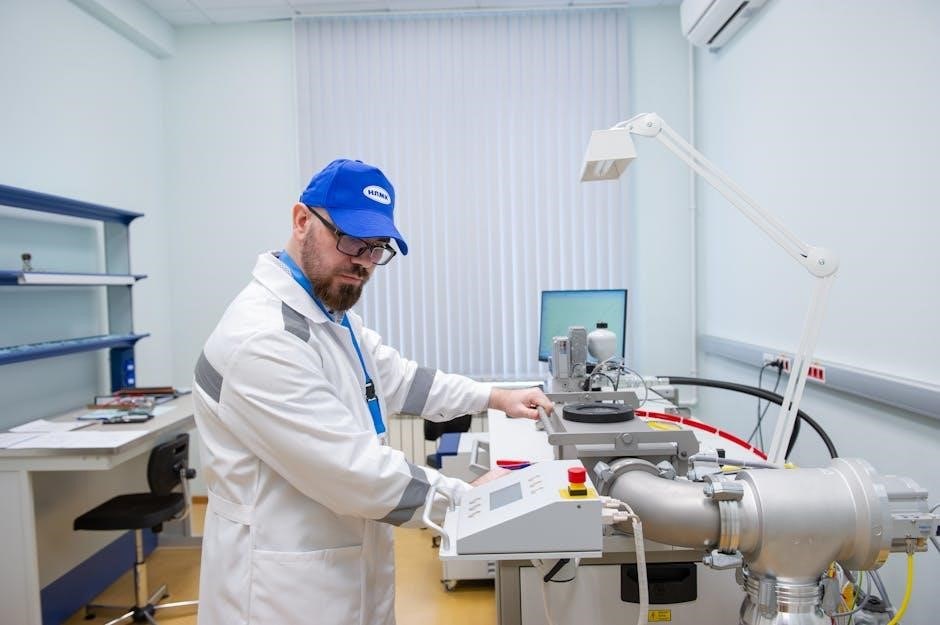Welcome to the Tenmatech Wireless Microphone Manual! This comprehensive guide provides detailed instructions for setting up‚ operating‚ and maintaining your wireless microphone system effectively. Designed to ensure optimal performance‚ it covers everything from initial setup to advanced features‚ helping you achieve crystal-clear audio and seamless connectivity.
Overview of the Tenmatech Wireless Microphone System
The Tenmatech Wireless Microphone System is a high-quality‚ UHF dual-channel wireless solution designed for professional audio applications. It includes a transmitter and receiver‚ operating in the UHF band with PLL synthesis for stable performance. The system offers 200 channels‚ ensuring interference-free transmission. Key components include the T26 PA speaker‚ wireless microphone‚ remote control‚ and USB cable. Features like Automatic Gain Control (AGC) and noise cancellation enhance audio clarity. Built for versatility‚ it supports XLR and jack outputs‚ making it ideal for live performances‚ public speaking‚ and professional sound integration.
Importance of the Manual for Optimal Performance
The Tenmatech Wireless Microphone Manual is essential for unlocking the full potential of your system. It provides clear‚ step-by-step instructions for setup‚ operation‚ and troubleshooting‚ ensuring you achieve professional-grade audio. By following the manual‚ you can optimize frequency selection‚ minimize interference‚ and maintain sound quality. It also offers insights into advanced features like Automatic Gain Control and noise cancellation‚ helping you deliver flawless performances every time. This guide is your key to maximizing the system’s capabilities and longevity.

Safety Guidelines and Precautions
Always read and follow the manual carefully to ensure safe operation. Avoid exposure to moisture‚ extreme temperatures‚ and physical stress. Keep the system away from direct sunlight and heat sources.
General Safety Warnings
To ensure safe and reliable operation‚ read and follow all instructions in this manual carefully; Avoid exposing the system to liquids‚ extreme temperatures‚ or physical stress. Never drop or strike the components‚ as this may cause permanent damage. Use only approved power sources and accessories to prevent electrical hazards. Keep the system clean and dry‚ avoiding contact with flammable materials. Always unplug during storms or when not in use. For optimal safety‚ follow all local regulations and guidelines. If unsure‚ consult a professional for installation and maintenance.
Proper Handling and Storage Instructions
To maintain the longevity and performance of your Tenmatech Wireless Microphone System‚ handle it with care. Always use a soft‚ dry cloth to clean the microphone grille and avoid harsh chemicals. Store components in a cool‚ dry place‚ away from direct sunlight and humidity. Use the original packaging or protective cases to prevent damage during transport. Avoid bending or flexing the antennas‚ as this can impair signal quality. Properly secure cables to prevent tangling or stress on connectors. Regularly inspect for wear and tear‚ addressing issues promptly to ensure optimal performance.
Carefully unpack your Tenmatech Wireless Microphone System‚ ensuring all components are included and undamaged. Verify the transmitter‚ receiver‚ batteries‚ remote control‚ USB cable‚ and user manual are present. The Tenmatech Wireless Microphone System comes with essential components for seamless operation. Inside the box‚ you’ll find the wireless microphone transmitter‚ audio receiver‚ remote control for convenient adjustments‚ a USB cable for firmware updates‚ and a comprehensive user manual. Additionally‚ the package includes a set of batteries to power the devices. Ensure all items are present and in good condition before proceeding with setup to guarantee optimal performance and functionality. Properly check each component to avoid any issues during installation. Before proceeding‚ carefully inspect all components for any visible damage or defects. Verify that the wireless microphone‚ receiver‚ remote control‚ USB cable‚ and user manual are included. Ensure the packaging is intact and no items are missing. If any damage or discrepancies are found‚ contact the supplier immediately. This step is crucial to ensure proper functionality and avoid potential issues during setup. Always refer to the manual for a detailed list of included items and guidance on inspection. The Tenmatech Wireless Microphone System operates in the UHF band‚ featuring PLL synthesis and dual-channel capability. It includes advanced features like automatic gain control (AGC) and noise cancellation‚ ensuring high-quality audio transmission and reliability. Designed for professional integration‚ the system offers a robust and interference-free performance. The Tenmatech Wireless Microphone System consists of a transmitter (microphone) and a receiver. The transmitter captures audio and sends it wirelessly to the receiver‚ which connects to your sound system. Key components include the handheld microphone‚ remote control‚ USB cable‚ and receiver with antennas. The system also features XLR and Jack outputs for professional integration‚ a display for monitoring settings‚ and an IR Sync port for frequency pairing. Additionally‚ it includes a DC 12V/18V power input for reliable operation. The Tenmatech Wireless Microphone System offers advanced features for superior audio quality and convenience. Automatic Gain Control (AGC) adjusts audio levels dynamically‚ ensuring clear and balanced sound without manual intervention. Noise Cancellation minimizes background interference‚ delivering crisp performance. The system also includes PLL Synthesizer Technology‚ providing stable frequency operation and reducing signal dropouts. With 200-channel UHF options‚ users can select optimal frequencies for interference-free transmission. These features make it ideal for professional live performances and public speaking engagements. For a seamless experience‚ refer to the setup guide in the Tenmatech Wireless Microphone Manual. Connect the microphone and receiver‚ install batteries‚ and sync frequencies for optimal performance. Power on the microphone and receiver. Ensure both devices are set to the same frequency channel. Connect the receiver to your sound system using XLR or 1/4-inch jack outputs. Test audio by speaking into the microphone and adjusting the receiver’s volume for optimal sound quality. Sync the devices if necessary‚ using the IR sync feature or manual frequency adjustment. Confirm functionality by monitoring the signal strength and audio output. Insert the provided batteries into both the microphone and receiver‚ ensuring correct polarity. For rechargeable batteries‚ connect the devices to a power source using the included USB cable. Turn on the power switch located on the microphone and receiver. Wait for the LED indicators to light up‚ signaling the system is powered on. Allow a few seconds for the system to initialize and establish a connection. The system is now ready for use‚ with a typical battery life of up to 15 hours. Understand frequency options to optimize signal strength and reduce interference. Select the right channel for your environment and use automatic frequency selection for the best connection. The Tenmatech Wireless Microphone System operates in the UHF band‚ offering a reliable and wide range of frequencies to minimize interference. With PLL (Phase-Locked Loop) synthesis‚ the system ensures stable and consistent signal transmission. Users can select from multiple frequency groups‚ each containing several channels‚ to find the best option for their environment. This flexibility allows for optimal performance in various settings‚ reducing dropout risks and ensuring high-quality audio transmission. Understanding these frequency options is crucial for achieving a strong‚ interference-free connection. To ensure optimal performance‚ position the antennas on the receiver and transmitter for maximum signal strength. Select a frequency channel with minimal interference using the IR sync function or manual adjustment. Avoid physical obstructions between the microphone and receiver‚ as they can weaken the signal. Use the Automatic Gain Control (AGC) to balance audio levels and reduce noise. Regularly check for firmware updates and maintain a clear line of sight to minimize interference and ensure reliable transmission. Connect the receiver to your sound system using XLR or Jack outputs for professional integration. Ensure proper input levels on the amplifier or soundboard for optimal performance. To connect the receiver to your sound system‚ use an XLR cable to link the receiver’s XLR output to the amplifier or soundboard’s MIC or LINE input. Ensure the XLR cable is securely plugged into both ports. For systems without XLR inputs‚ a 1/4″ Jack adapter can be used. Adjust the gain settings on the amplifier to achieve optimal audio levels. Properly routing the signal ensures clear and balanced sound output‚ free from distortion or interference. This step is crucial for professional integration and high-quality audio performance. For professional audio integration‚ the Tenmatech Wireless Microphone System offers both XLR and Jack outputs. The XLR output provides a balanced audio signal‚ ideal for connecting to professional soundboards or mixers‚ minimizing noise and interference. The Jack output is suitable for consumer-grade equipment‚ offering flexibility for various setups. Ensure proper cable connections and adjust output levels to match your system’s requirements for optimal sound quality. This dual-output feature enhances versatility‚ catering to both professional and casual audio needs. Turn on the microphone and ensure the receiver is powered. Check the signal strength and adjust settings as needed for optimal performance and clear audio. Always handle the microphone with care to maintain sound quality and durability. Use a firm but gentle grip‚ avoiding direct contact with the grille to prevent damage. Keep the microphone clean by lightly wiping it with a dry cloth. Position it correctly‚ aiming it toward the sound source for optimal pickup. Avoid exposing it to extreme temperatures or moisture‚ and store it securely when not in use. Proper handling ensures reliable performance and extends the lifespan of your wireless microphone system. Regularly monitor the wireless microphone system to ensure optimal performance. Check the receiver’s display for signal strength and adjust antennas if interference occurs. Use the volume controls to balance audio levels‚ and enable features like Automatic Gain Control (AGC) for consistent sound quality. Keep the microphone at least 6 inches from speakers to prevent feedback. Periodically test battery levels and replace them when necessary. Adjust settings as needed to maintain clear‚ distortion-free audio throughout your performance or presentation. Refer to the manual for specific guidance. Achieve exceptional audio clarity with the Tenmatech Wireless Microphone System. Minimize background noise by adjusting gain settings and using Automatic Gain Control (AGC) for balanced sound. To ensure crystal-clear audio‚ minimize background noise by adjusting the microphone’s gain settings and using the Automatic Gain Control (AGC) feature. Position antennas optimally to reduce interference and operate on frequencies with less congestion. Avoid placing the microphone near electronic devices and use noise-canceling features. Regularly test audio levels and adjust as needed. Proper handling‚ such as avoiding touching the mic during use‚ further enhances sound quality. These steps ensure a professional-grade audio experience. The Tenmatech Wireless Microphone system features an advanced Automatic Gain Control (AGC) that automatically adjusts audio levels to maintain optimal sound balance. This function ensures that your voice remains clear and consistent‚ eliminating the need for manual adjustments during performances or recordings. By compensating for volume fluctuations‚ AGC enhances overall audio quality‚ minimizing distortion and providing a professional-grade output. This feature is especially useful in dynamic environments where sound levels may vary frequently. Identify and resolve connectivity problems by checking power‚ battery status‚ and signal settings. Ensure devices are turned on and properly paired. Move antennas for better reception and check for interference sources like nearby electronics or physical obstructions. Restart the system if issues persist‚ and consult the manual for detailed solutions. Begin by verifying that both the microphone transmitter and receiver are powered on and set to the same frequency or channel. Check for low battery levels‚ as this can cause intermittent signal loss. Ensure the receiver’s antennas are positioned optimally to maximize signal strength. If issues persist‚ restart both devices and re-sync the transmitter with the receiver using the infrared sync feature. If problems remain‚ consult the manual for advanced troubleshooting steps or reset the system to its factory settings. If you experience audio distortion or loss of signal‚ first check for interference from nearby electronic devices or other wireless systems. Ensure the transmitter and receiver are on the same frequency and that antennas are positioned optimally. Move the receiver away from metal objects or sources of interference. If distortion persists‚ adjust the sensitivity settings or replace the batteries. Restarting both devices and re-syncing them can also resolve signal issues. Refer to the manual for advanced troubleshooting steps. Regularly clean the microphone grille with damp sterile wipes and inspect for wear. Replace batteries as needed and update firmware for optimal performance and longevity. Regular cleaning ensures optimal performance. Use a soft‚ dry cloth to wipe the microphone grille and receiver surfaces. For stubborn debris‚ lightly dampen the cloth with water‚ avoiding harsh chemicals. Gently scrub the grille‚ then dry thoroughly. Avoid moisture inside the components. Clean the receiver’s exterior and vents with a dry cloth‚ ensuring dust-free operation. For hygiene‚ use sterile wipes on the microphone grille. Clean after each use to prevent dirt buildup and maintain sound quality. Regular maintenance extends the lifespan of your system. To maintain performance‚ replace batteries when power is low. Use high-quality‚ compatible batteries‚ ensuring correct polarity. For firmware updates‚ visit the manufacturer’s website‚ download the latest version‚ and follow installation instructions. Updates enhance features‚ fix issues‚ and improve security. Regularly check for updates to keep your system optimized. Always power off the device before replacing batteries or updating firmware to prevent damage. Proper maintenance ensures reliable operation and extends the lifespan of your Tenmatech Wireless Microphone System. Thank you for choosing the Tenmatech Wireless Microphone System! Proper care‚ regular updates‚ and adherence to guidelines ensure optimal performance. Explore advanced features and refer to this manual for guidance. Happy broadcasting! To extend the lifespan of your Tenmatech Wireless Microphone System‚ ensure proper handling‚ storage‚ and maintenance. Regularly clean the microphone grille with sterile wipes and avoid exposure to moisture. Store the system in a dry‚ cool environment away from direct sunlight. Always update firmware to the latest version for optimal performance. Replace batteries when necessary and use high-quality replacements. Avoid extreme temperatures and physical stress on components. By following these guidelines‚ you’ll ensure reliable operation and longevity of your system. Regularly updating your Tenmatech Wireless Microphone System’s firmware ensures optimal performance and access to new features. Check the Tenmatech website for the latest firmware versions and follow the update instructions provided in the manual. Additionally‚ refer to online guides and troubleshooting resources for tips on improving sound quality and resolving common issues. Keeping your system up-to-date guarantees enhanced functionality and a superior user experience.
Unpacking and Inventory
What’s Included in the Box
Checking for Damages or Missing Components

System Components and Features
Key Parts of the Wireless Microphone System
Advanced Features for Enhanced Performance

Installation and Setup
Step-by-Step Guide to Connecting the Microphone and Receiver
Installing Batteries and Powering On the System

Frequency Selection and Channel Assignment
Understanding Frequency Options
Optimizing Signal Strength and Reducing Interference

Connecting to a Sound System
Linking the Receiver to an Amplifier or Soundboard
Using XLR and Jack Outputs for Professional Integration

Operating the Wireless Microphone
Best Practices for Handling the Microphone
Monitoring and Adjusting Settings During Use
Sound Quality and Optimization
Minimizing Background Noise and Interference
Using Automatic Gain Control (AGC) for Balanced Audio
Troubleshooting Common Issues
Identifying and Resolving Connectivity Problems

Addressing Audio Distortion or Loss of Signal

Maintenance and Upkeep
Cleaning the Microphone and Receiver
Replacing Batteries and Updating Firmware
Maximizing the Lifespan of Your Wireless Microphone System
Staying Updated with the Latest Firmware and Guides






























